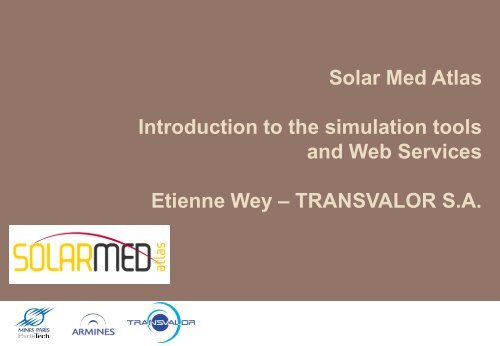Solar Med Atlas Introduction to the simulation tools and Web ...
Solar Med Atlas Introduction to the simulation tools and Web ...
Solar Med Atlas Introduction to the simulation tools and Web ...
You also want an ePaper? Increase the reach of your titles
YUMPU automatically turns print PDFs into web optimized ePapers that Google loves.
<strong>Solar</strong> <strong>Med</strong> <strong>Atlas</strong><br />
<strong>Introduction</strong> <strong>to</strong> <strong>the</strong> <strong>simulation</strong> <strong>to</strong>ols<br />
<strong>and</strong> <strong>Web</strong> Services<br />
Etienne Wey – TRANSVALOR S.A.
2<br />
Satellite-based car<strong>to</strong>graphy of <strong>Solar</strong> Resource<br />
Two solar databases<br />
• SOLEMI (DLR): 1991 - 2004<br />
• HelioClim-3 (MINES ParisTech / Transvalor)<br />
2005 – 2011<br />
Heliosat-based methods<br />
Use of Meteosat imagery<br />
• Meteosat First Generation (1985 – 2005)<br />
• Meteosat Second Generation (since 2004)<br />
Spatial resolution: ~ 3 – 4 km<br />
<strong>Introduction</strong><br />
<strong>Solar</strong> <strong>Atlas</strong> for <strong>the</strong> <strong>Med</strong>iterranean<br />
Training Workshop – Marrakech - Sep. 13st, 2012
3<br />
<strong>Introduction</strong><br />
Focus on<br />
Turkey, Syria, Lebanon, Jordan, Israel,<br />
Palestine National Authority, Egypt,<br />
Libya, Tunisia, Algeria, Morocco,<br />
<strong>and</strong> Mauretania<br />
Global, Diffuse <strong>and</strong> Direct irradiations<br />
(Tilted plans, normal incidence)<br />
Spatial resolution: 1 km<br />
with orographic effects<br />
Variation of <strong>the</strong> length of <strong>the</strong> optical path due <strong>to</strong> <strong>the</strong> local 1-km<br />
altitude derived from <strong>the</strong> Digital Elevation Model SRTM<br />
Shadow effects from SRTM-derived horizon<br />
Temporal resolution: monthly irradiations<br />
from 1991 <strong>to</strong> 2010<br />
<strong>Solar</strong> <strong>Atlas</strong> for <strong>the</strong> <strong>Med</strong>iterranean<br />
Training Workshop – Marrakech - Sep. 13st, 2012
<strong>Introduction</strong><br />
4<br />
The potential end-users <strong>and</strong> usages of a solar atlas:<br />
Governmental <strong>and</strong> private ac<strong>to</strong>rs<br />
• Geographical analysis of local solar potential<br />
• Sitting <strong>and</strong> sizing solar power plants<br />
Advanced feasibility pre-studies based on geographical analysis<br />
(before, for example, a local installation of a pyranometric station)<br />
Individual<br />
• High resolution map suitable for sizing small individual solar systems<br />
(small PV system, solar water heating systems, etc)<br />
• Accurate <strong>and</strong> well-presented solar maps are concrete <strong>and</strong> instructive for<br />
everybody (e.g. education) <strong>to</strong> promote solar energy<br />
<strong>Solar</strong> <strong>Atlas</strong> for <strong>the</strong> <strong>Med</strong>iterranean<br />
Training Workshop – Marrakech - Sep. 13st, 2012
<strong>Introduction</strong><br />
5<br />
Data dissemination:<br />
Dedicated web-based interface<br />
at www.solar-med-atlas.org<br />
Distributed architecture<br />
compliant <strong>to</strong> <strong>the</strong><br />
GEOSS / OGC architecture<br />
• <strong>Web</strong> Map Services<br />
for GIS-based analysis<br />
• <strong>Web</strong> Processing Services<br />
for solar estimation at a<br />
given geo-point<br />
<strong>Solar</strong> <strong>Atlas</strong> for <strong>the</strong> <strong>Med</strong>iterranean<br />
Training Workshop – Marrakech - Sep. 13st, 2012
Yearly average BNI map from<br />
Helioclim3 data (2004-2010)<br />
6<br />
<strong>Solar</strong> <strong>Atlas</strong> for <strong>the</strong> <strong>Med</strong>iterranean<br />
Training Workshop – Marrakech - Sep. 13st, 2012
Application from <strong>the</strong> solar atlas<br />
7<br />
<br />
Creation of maps <strong>to</strong> determine “best” potential solar sites<br />
« Geophysial »<br />
conditions analysis<br />
(slope <strong>and</strong> l<strong>and</strong> cover)<br />
Electrical grid analysis<br />
Exclusion maps<br />
creation<br />
Best<br />
potential<br />
sites<br />
identification<br />
<strong>Solar</strong> <strong>Atlas</strong> for <strong>the</strong> <strong>Med</strong>iterranean<br />
Training Workshop – Marrakech - Sep. 13st, 2012
Getting <strong>the</strong> BNI <strong>and</strong> SRTM data<br />
8<br />
The BNI maps can be downloaded from <strong>the</strong> <strong>Web</strong><br />
Map Service for <strong>the</strong> Morocco zone<br />
wget -O BNI_Morocco.tif http://www.solar-medatlas.org/mapserv/solar_med_atlas?SERVICE=WMS&VERSIO<br />
N=1.3.0&REQUEST=GetMap&BBOX=20.7,-17.25,36.2,-<br />
0.6&CRS=EPSG:4326&WIDTH=1998&HEIGHT=1860&LAYER<br />
S=solar_med_atlas_BNI_16bits&FORMAT=image/tiff<br />
Same procedure <strong>to</strong> get <strong>the</strong> SRTM 16 bits image<br />
This can be executed in a Windows .bat file<br />
<strong>Solar</strong> <strong>Atlas</strong> for <strong>the</strong> <strong>Med</strong>iterranean<br />
Training Workshop – Marrakech - Sep. 13st, 2012
Getting <strong>the</strong> l<strong>and</strong> cover <strong>and</strong> o<strong>the</strong>r data<br />
9<br />
For <strong>the</strong> l<strong>and</strong>cover, we use <strong>the</strong> GLOBCOVER map,<br />
restricted <strong>to</strong> <strong>the</strong> same zone with <strong>the</strong> same pixel size<br />
(0.00833206° ~1km) (desert area value is 200)<br />
The country boundary <strong>and</strong> power lines are obtained<br />
as shape files from <strong>the</strong> DIVA GIS web site. You must<br />
best use your own data for <strong>the</strong> power lines…<br />
<strong>Solar</strong> <strong>Atlas</strong> for <strong>the</strong> <strong>Med</strong>iterranean<br />
Training Workshop – Marrakech - Sep. 13st, 2012
Creating <strong>the</strong> exclusion maps<br />
10<br />
In Qgis, we use <strong>the</strong> raster calcula<strong>to</strong>r <strong>to</strong> compute a<br />
mask combining <strong>the</strong> zones of :<br />
(l<strong>and</strong>cover=200) AND (slope
Final exclusion map<br />
11<br />
<strong>Solar</strong> <strong>Atlas</strong> for <strong>the</strong> <strong>Med</strong>iterranean<br />
Training Workshop – Marrakech - Sep. 13st, 2012
Conclusion<br />
12<br />
<br />
<br />
Creation of a potential “best” sites map<br />
Exclusion zones based mainly on l<strong>and</strong> cover <strong>and</strong> Digital Elevation Model<br />
Fur<strong>the</strong>r exclusion based on :<br />
• Distance from electricity grid source points<br />
Fine local assessment for <strong>the</strong> site need <strong>the</strong>n<br />
Installation of an irradiation measurement ground station<br />
Calibration of <strong>the</strong> satellite data with <strong>the</strong> ground station<br />
Creation of TMY time series (P50, P90) <strong>to</strong> calculate <strong>the</strong> solar energy project<br />
yield<br />
<strong>Solar</strong> <strong>Atlas</strong> for <strong>the</strong> <strong>Med</strong>iterranean<br />
Training Workshop – Marrakech - Sep. 13st, 2012


